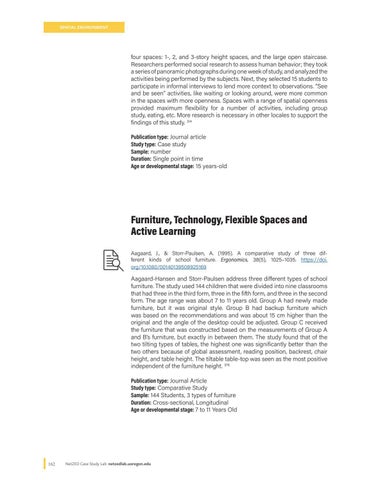SPATIAL ENVIRONMENT
four spaces: 1-, 2, and 3-story height spaces, and the large open staircase. Researchers performed social research to assess human behavior; they took a series of panoramic photographs during one week of study, and analyzed the activities being performed by the subjects. Next, they selected 15 students to participate in informal interviews to lend more context to observations. “See and be seen” activities, like waiting or looking around, were more common in the spaces with more openness. Spaces with a range of spatial openness provided maximum flexibility for a number of activities, including group study, eating, etc. More research is necessary in other locales to support the findings of this study. 314 Publication type: Journal article Study type: Case study Sample: number Duration: Single point in time Age or developmental stage: 15 years-old
Furniture, Technology, Flexible Spaces and Active Learning Aagaard, J., & Storr-Paulsen, A. (1995). A comparative study of three different kinds of school furniture. Ergonomics, 38(5), 1025–1035. https://doi. org/10.1080/00140139508925169
Aagaard-Hansen and Storr-Paulsen address three different types of school furniture. The study used 144 children that were divided into nine classrooms that had three in the third form, three in the fifth form, and three in the second form. The age range was about 7 to 11 years old. Group A had newly made furniture, but it was original style. Group B had backup furniture which was based on the recommendations and was about 15 cm higher than the original and the angle of the desktop could be adjusted. Group C received the furniture that was constructed based on the measurements of Group A and B’s furniture, but exactly in between them. The study found that of the two tilting types of tables, the highest one was significantly better than the two others because of global assessment, reading position, backrest, chair height, and table height. The tiltable table-top was seen as the most positive independent of the furniture height. 378 Publication type: Journal Article Study type: Comparative Study Sample: 144 Students, 3 types of furniture Duration: Cross-sectional, Longitudinal Age or developmental stage: 7 to 11 Years Old
162
NetZED Case Study Lab netzedlab.uoregon.edu

